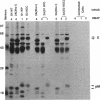Abstract
Dengue virus contains an 11-kilobase positive-strand RNA genome that codes for, in one open reading frame, three structural proteins (capsid, premembrane, and envelope), followed by seven nonstructural proteins. The structural protein genes of a full-length cDNA clone of type 4 dengue virus were replaced with the corresponding genes of dengue 1 or dengue 2 to create intertypic chimeric cDNA. The RNA transcripts made from these templates were infectious when transfected into permissive cells in culture. Progeny of chimeric cDNA produced apparently authentic dengue 1 or dengue 2 structural proteins, together with dengue 4 nonstructural proteins, and as a consequence exhibited type 1 or type 2 serological specificity. Both of the chimeras ultimately grew to the same titer as their type 1 or type 2 parent, but the type 2/type 4 chimera grew very slowly. This chimera also produced small plaques; in contrast, the type 1/type 4 chimera produced normal size plaques. The type 2/type 4 chimera retained the mouse neurovirulence of the dengue 2 virus, which was the source of its structural protein genes. Each of the mice inoculated intracerebrally with the chimera died, but survival time was prolonged. The retardation of replication of the type 2/type 4 chimeric virus suggests that this virus and possibly other intertypic dengue virus chimeras with similar properties should be examined for attenuation in primates and possible usefulness in a live dengue virus vaccine for humans.
Full text
PDF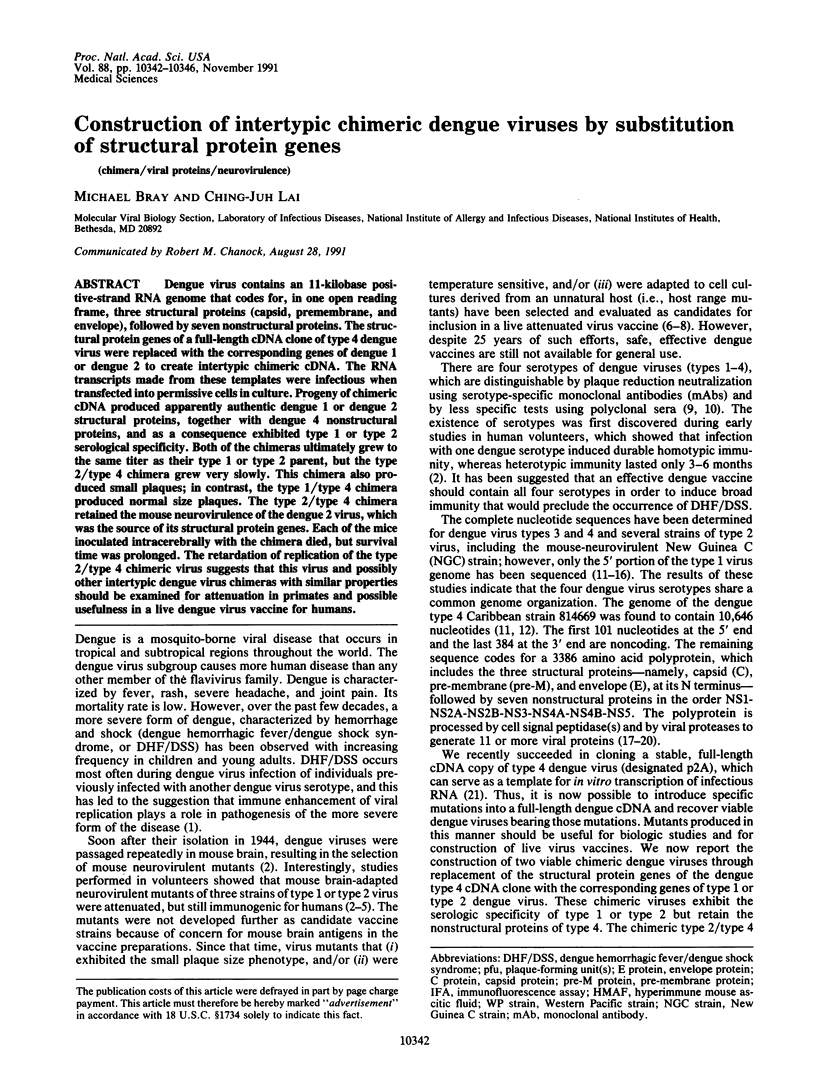
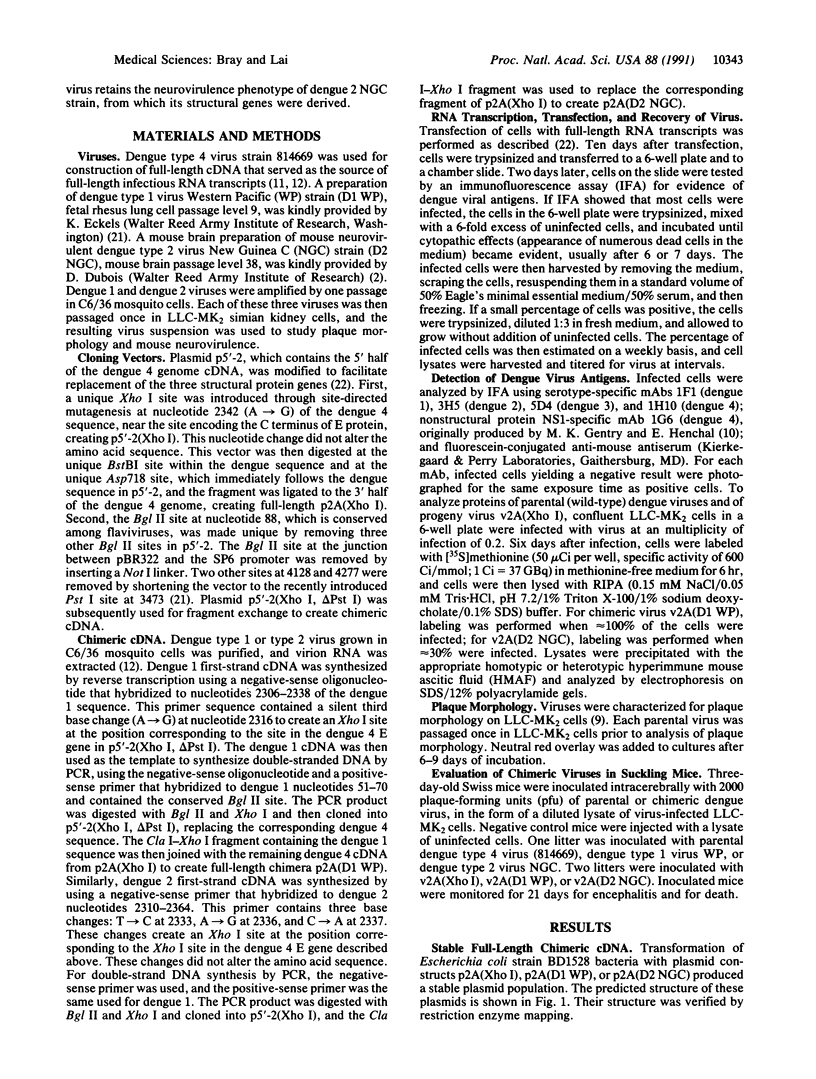
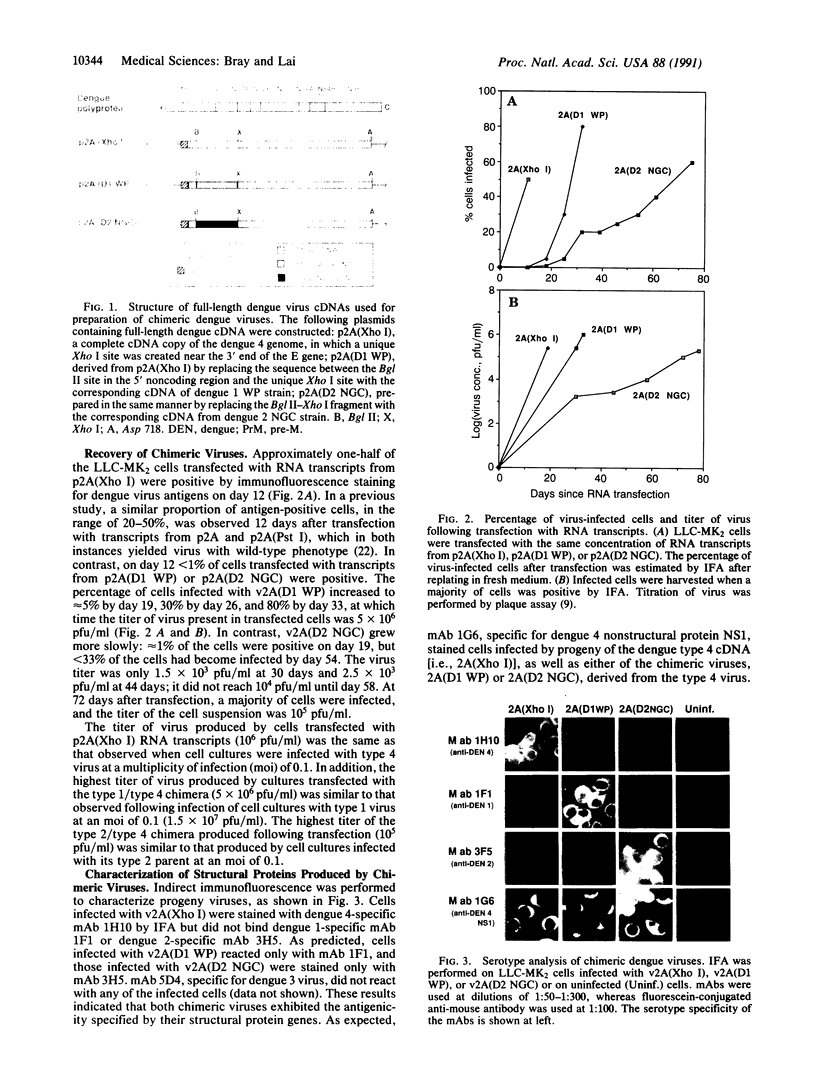
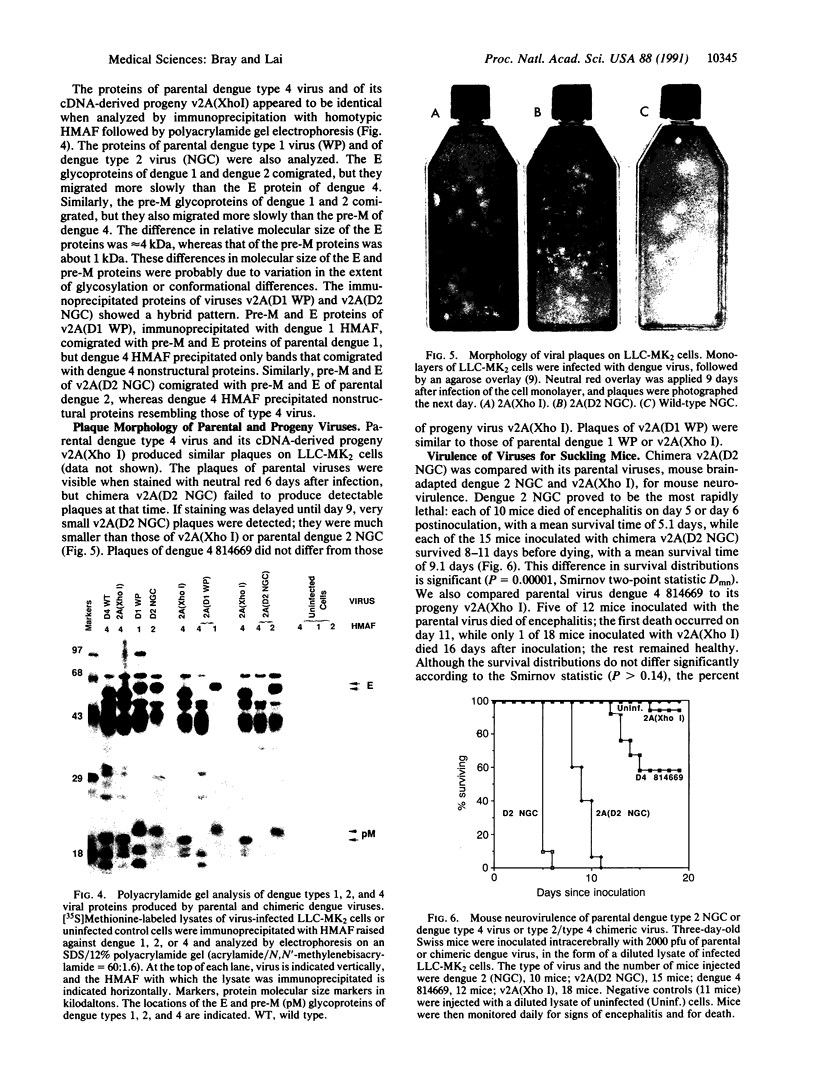
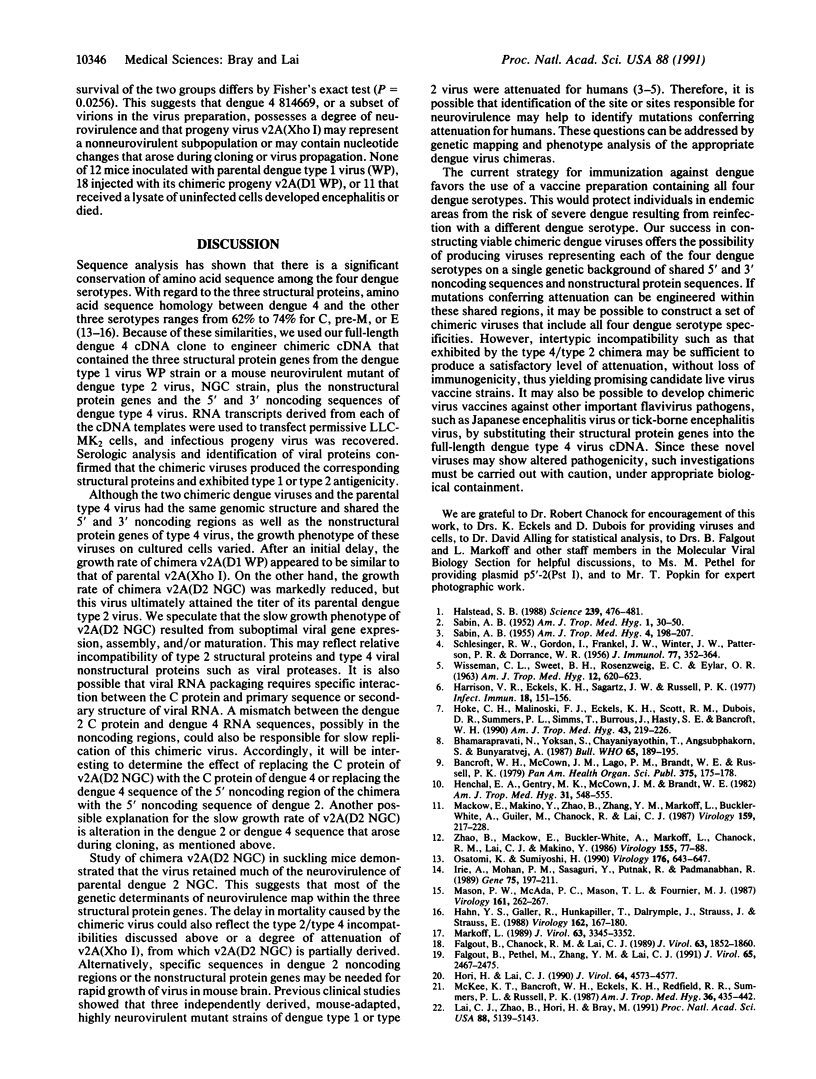
Images in this article
Selected References
These references are in PubMed. This may not be the complete list of references from this article.
- Bhamarapravati N., Yoksan S., Chayaniyayothin T., Angsubphakorn S., Bunyaratvej A. Immunization with a live attenuated dengue-2-virus candidate vaccine (16681-PDK 53): clinical, immunological and biological responses in adult volunteers. Bull World Health Organ. 1987;65(2):189–195. [PMC free article] [PubMed] [Google Scholar]
- DORRANCE W. R., FRANKEL J. W., GORDON I., PATTERSON P. R., SCHLESINGER R. W., WINTER J. W. Clinical and serologic response of man to immunization with attenuated dengue and yellow fever viruses. J Immunol. 1956 Nov;77(5):352–364. [PubMed] [Google Scholar]
- Falgout B., Chanock R., Lai C. J. Proper processing of dengue virus nonstructural glycoprotein NS1 requires the N-terminal hydrophobic signal sequence and the downstream nonstructural protein NS2a. J Virol. 1989 May;63(5):1852–1860. doi: 10.1128/jvi.63.5.1852-1860.1989. [DOI] [PMC free article] [PubMed] [Google Scholar]
- Falgout B., Pethel M., Zhang Y. M., Lai C. J. Both nonstructural proteins NS2B and NS3 are required for the proteolytic processing of dengue virus nonstructural proteins. J Virol. 1991 May;65(5):2467–2475. doi: 10.1128/jvi.65.5.2467-2475.1991. [DOI] [PMC free article] [PubMed] [Google Scholar]
- Gentry M. K., Henchal E. A., McCown J. M., Brandt W. E., Dalrymple J. M. Identification of distinct antigenic determinants on dengue-2 virus using monoclonal antibodies. Am J Trop Med Hyg. 1982 May;31(3 Pt 1):548–555. doi: 10.4269/ajtmh.1982.31.548. [DOI] [PubMed] [Google Scholar]
- Hahn Y. S., Galler R., Hunkapiller T., Dalrymple J. M., Strauss J. H., Strauss E. G. Nucleotide sequence of dengue 2 RNA and comparison of the encoded proteins with those of other flaviviruses. Virology. 1988 Jan;162(1):167–180. doi: 10.1016/0042-6822(88)90406-0. [DOI] [PubMed] [Google Scholar]
- Halstead S. B. Pathogenesis of dengue: challenges to molecular biology. Science. 1988 Jan 29;239(4839):476–481. doi: 10.1126/science.3277268. [DOI] [PubMed] [Google Scholar]
- Harrison V. R., Eckels K. H., Sagartz J. W., Russell P. K. Virulence and immunogenicity of a temperature-sensitive dengue-2 virus in lower primates. Infect Immun. 1977 Oct;18(1):151–156. doi: 10.1128/iai.18.1.151-156.1977. [DOI] [PMC free article] [PubMed] [Google Scholar]
- Hoke C. H., Jr, Malinoski F. J., Eckels K. H., Scott R. M., Dubois D. R., Summers P. L., Simms T., Burrous J., Hasty S. E., Bancroft W. H. Preparation of an attenuated dengue 4 (341750 Carib) virus vaccine. II. Safety and immunogenicity in humans. Am J Trop Med Hyg. 1990 Aug;43(2):219–226. doi: 10.4269/ajtmh.1990.43.219. [DOI] [PubMed] [Google Scholar]
- Hori H., Lai C. J. Cleavage of dengue virus NS1-NS2A requires an octapeptide sequence at the C terminus of NS1. J Virol. 1990 Sep;64(9):4573–4577. doi: 10.1128/jvi.64.9.4573-4577.1990. [DOI] [PMC free article] [PubMed] [Google Scholar]
- Irie K., Mohan P. M., Sasaguri Y., Putnak R., Padmanabhan R. Sequence analysis of cloned dengue virus type 2 genome (New Guinea-C strain). Gene. 1989 Feb 20;75(2):197–211. doi: 10.1016/0378-1119(89)90266-7. [DOI] [PubMed] [Google Scholar]
- Lai C. J., Zhao B. T., Hori H., Bray M. Infectious RNA transcribed from stably cloned full-length cDNA of dengue type 4 virus. Proc Natl Acad Sci U S A. 1991 Jun 15;88(12):5139–5143. doi: 10.1073/pnas.88.12.5139. [DOI] [PMC free article] [PubMed] [Google Scholar]
- Mackow E., Makino Y., Zhao B. T., Zhang Y. M., Markoff L., Buckler-White A., Guiler M., Chanock R., Lai C. J. The nucleotide sequence of dengue type 4 virus: analysis of genes coding for nonstructural proteins. Virology. 1987 Aug;159(2):217–228. doi: 10.1016/0042-6822(87)90458-2. [DOI] [PubMed] [Google Scholar]
- Markoff L. In vitro processing of dengue virus structural proteins: cleavage of the pre-membrane protein. J Virol. 1989 Aug;63(8):3345–3352. doi: 10.1128/jvi.63.8.3345-3352.1989. [DOI] [PMC free article] [PubMed] [Google Scholar]
- Mason P. W., McAda P. C., Mason T. L., Fournier M. J. Sequence of the dengue-1 virus genome in the region encoding the three structural proteins and the major nonstructural protein NS1. Virology. 1987 Nov;161(1):262–267. doi: 10.1016/0042-6822(87)90196-6. [DOI] [PubMed] [Google Scholar]
- McKee K. T., Jr, Bancroft W. H., Eckels K. H., Redfield R. R., Summers P. L., Russell P. K. Lack of attenuation of a candidate dengue 1 vaccine (45AZ5) in human volunteers. Am J Trop Med Hyg. 1987 Mar;36(2):435–442. doi: 10.4269/ajtmh.1987.36.435. [DOI] [PubMed] [Google Scholar]
- Osatomi K., Sumiyoshi H. Complete nucleotide sequence of dengue type 3 virus genome RNA. Virology. 1990 Jun;176(2):643–647. doi: 10.1016/0042-6822(90)90037-r. [DOI] [PubMed] [Google Scholar]
- SABIN A. B. Recent advances in our knowledge of dengue and sandfly fever. Am J Trop Med Hyg. 1955 Mar;4(2):198–207. doi: 10.4269/ajtmh.1955.4.198. [DOI] [PubMed] [Google Scholar]
- SABIN A. B. Research on dengue during World War II. Am J Trop Med Hyg. 1952 Jan;1(1):30–50. doi: 10.4269/ajtmh.1952.1.30. [DOI] [PubMed] [Google Scholar]
- Zhao B., Mackow E., Buckler-White A., Markoff L., Chanock R. M., Lai C. J., Makino Y. Cloning full-length dengue type 4 viral DNA sequences: analysis of genes coding for structural proteins. Virology. 1986 Nov;155(1):77–88. doi: 10.1016/0042-6822(86)90169-8. [DOI] [PubMed] [Google Scholar]






